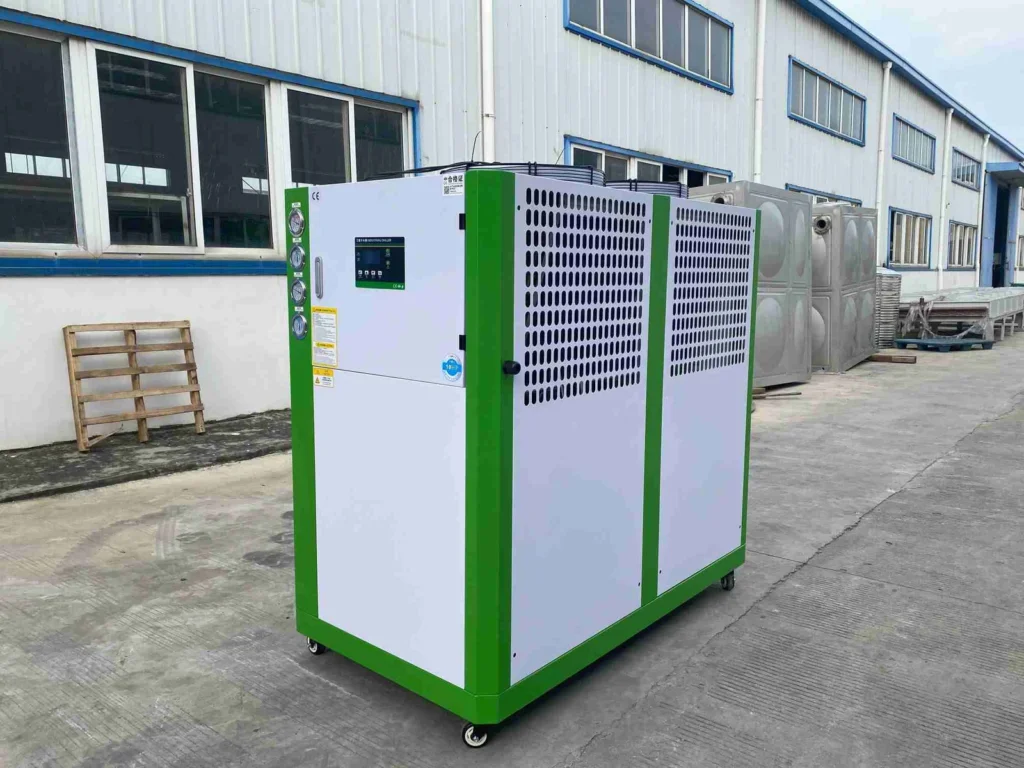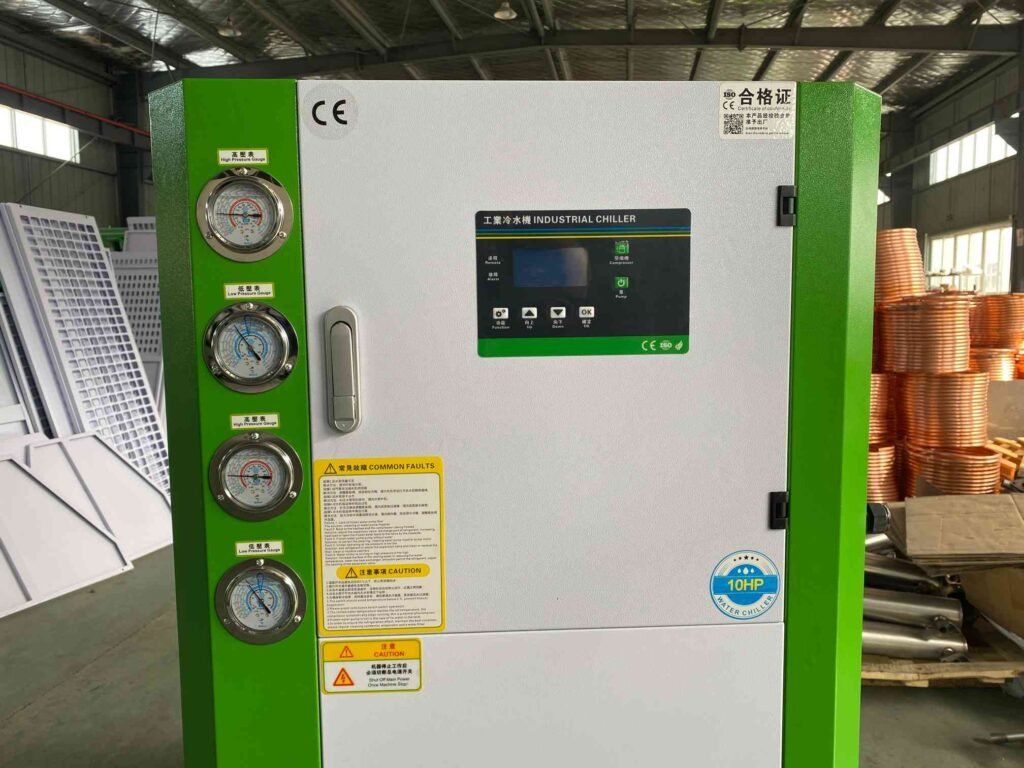Industrial chillers are vital refrigeration equipment in contemporary industrial production. Their sizing guarantees maximum operation and stability during the entire production process. The appropriate chiller size improves production efficiency and significantly reduces operating costs. This paper presents a detailed selection guide to help you accurately determine the size of an industrial water chiller.
I. Define Cooling Requirements: The Foundation of Selection
The first step in determining industrial chiller sizing is to clearly define your cooling requirements. This involves understanding the equipment’s operating power, heat generation during production processes, and the required cooling temperature range. Specifically, you need to consider the following aspects:
1. Equipment Power
Industrial chillers are essential refrigeration machines for modern industrial production. Their sizing ensures optimum running and steadiness of the whole production process. The right size of a chiller improves the efficiency of production and reduces the cost of operation to a great extent. This paper provides an elaborate selection guide that will help you determine accurately the size of an industrial water chiller.
2. Cooling Medium
Common cooling media include water and ethylene glycol solutions. Different media possess varying specific heat capacities, which impact the chiller’s cooling capacity calculations.
3. Temperature Difference
Determine the inlet-to-outlet temperature difference (ΔT) of the cooling water. A larger temperature difference requires less cooling capacity, but excessively large differences may compromise equipment cooling efficiency.
Using this information, you can make a preliminary estimate of the required cooling capacity. For example, if your equipment operates at 50 kW, uses water as the cooling medium, and has an inlet/outlet temperature difference of 5°C, you can calculate using the following formula:
Cooling Capacity (kW) = Flow Rate (m³/hr) × Specific Heat Capacity (kJ/kg·K) × Temperature Difference (ΔT)
Assuming a flow rate of 10 m³/hr and water’s specific heat capacity of 4.18 kJ/kg·K, the cooling capacity is:
Cooling Capacity = 10 × 4.18 × 5 = 209 kW
II. Precise Cooling Capacity Calculation: The Core of Equipment Selection
Refrigeration capacity forms the main parameter in industrial water chiller sizing. Accurate computation involves many factors, such as flow rate, specific heat capacity, and temperature difference. Other considerations include the efficiency of heat exchange in the system and the impact of ambient temperature.
1. Flow Rate and Specific Heat Capacity
Let the flow rate of the cooling system be found, and the specific heat capacity of the medium used for cooling be determined. The measurement can be undertaken using a flow meter, while specific heat capacity relates to the type of medium used for cooling.
2. Temperature Difference
Record the difference in temperature between the inlet and outlet cooling water. A greater difference reduces the required capacity, but it must ensure that it fulfills the performance requirement regarding adequate cooling of equipment.
3. Ambient Temperature
Think about how the surrounding temperature affects the work of the chiller. In conditions of high temperatures, greater capacity for cooling might be needed to make up for ambient heat loads.
4. Safety Factor
Add a safety factor of 10-20% to the computed result for maximum loads and space to consider in the future.
III. Selecting the Appropriate Industrial Chiller Type

After determining the cooling capacity, the next step is selecting a suitable industrial chiller unit type. Common types include air-cooled, water-cooled, and evaporative-cooled chillers. Each type has distinct advantages and disadvantages, suited for different applications:
1. Air-Cooled Chillers
It is easy to install because it does not require a cooling tower. Good for small equipment and for places where space is a problem. The efficiency of these units relies very heavily on the ambient temperature, though, possible reduced in high-heat conditions.
2. Water-Cooled Chillers
High cooling efficiency is appropriate for large machinery and applications where great cooling performance is achievable. It needs extra cooling towers and a cooling water system, thus higher installation as well as maintenance costs.

3. Evaporative cooling chillers
Combine the advantages of air-cooled and water-cooled systems, offering relatively high cooling efficiency with reduced dependence on ambient temperature. However, their complex structure results in higher maintenance costs.
When selecting the appropriate chiller type, also consider equipment compatibility and future expansion needs. For instance, if your equipment requires precise temperature control, a water-cooled chiller is recommended; if space and budget are constrained, an air-cooled chiller may be the better choice.
IV. How to Select a Reliable Manufacturer
1. Manufacturer Reputation
Choose manufacturers with a strong reputation and extensive experience, such as well-known brands like Senho. These manufacturers typically maintain robust quality control systems, ensuring industrial chiller service performance and reliability.
2. Reliable Cooling Solutions
Industrial chiller selection should ideally be based on the characteristics of the load curve and not on fulfilling maximum demand alone. For example, in injection molding, the requirement for cooling varies with the cycles of production. Variable Frequency Drive (VFD) Chillers save energy by more than 30%.
Also, system compatibility is a vastly underrated factor. Most companies think that if they buy the best main unit, their work is done, and forget about the synergy that auxiliary equipment like pumps and cooling towers also need to create. Professional industrial chiller manufacturers offer total solutions for the best performance matching of all components.
3. Technical Support
Choose brands that provide very wide technical support. Fast answers and help when there is a problem with the tools make sure the work keeps going.
4. After-Sales Service
Pick makers who offer great after-sales help. This has setup and start-up, training for users, normal care, and supply of spare parts to ensure long-term steady work.
V. Conclusión
Sizing an industrial water chiller is a sequential process involving an extensive assessment of cooling needs, calculation of refrigeration capacity, choosing the type of chiller, and its manufacturer. Clearly defining cooling requirements and accurately calculating refrigeration capacity ensures that the right type of chiller from a dependable manufacturer performs optimally during production to improve both production process efficiency and product quality. Professional technicians or sales engineers from the manufacturer should be involved in choosing industrial water coolers. They will base their recommendations on your situation by offering expert analysis and proposing customized solutions that will help you find the most appropriate industrial chiller.
